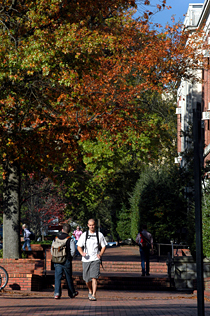By the Numbers
Facing another year of tight state budgets, NC State will focus on finding ways to decrease its dependence on state appropriations and to build its scholarship and endowment funding, leaders said Wednesday at a chancellor’s budget forum.
Warwick Arden, interim provost and executive vice chancellor, said the university is in “reasonably good shape” because it chose to make larger budget reductions than mandated, held on to reserves, received proceeds from tuition increases and collected almost $20 million in enrollment expansion funding.
However, Arden pointed out that the largest portion of NC State’s $1.24 billion budget—42 percent—comes from state appropriations. “We are very, very vulnerable to fluctuations in the state budget from year to year,” he said.
With a projected $3.5 to $4 billion shortfall in the state’s 2011-13 budget, NC State is again drafting cost-cutting plans, said Charles Leffler, vice chancellor for finance and business. The governor has asked the university to plan for a 5 or 10 percent reduction. In mid-October, NC State will submit plans to the UNC General Administration for 5, 10 and 15 percent cuts, representing reductions of $26 million, $53 million and $79 million, respectively.
Pay It Forward

Chancellor Randy Woodson said the strategic-planning process will help the university “change the game” by finding ways to build its teaching, research and service capacity in tough economic times. He said the resource strategies task force, led by David Bristol and Roby Sawyers, will take the lead, and that the final strategic plan will tie NC State’s goals to the financial resources needed to achieve them.
While NC State has enjoyed strong support from state legislators, the university needs to increase scholarships as well as need-based financial aid, Woodson said. He compared tuition rates to a car’s sticker price: Scholarships, like manufacturer incentives, can reduce the bottom line for students, he said.
While in-state students at Penn State pay $14,000 in tuition annually, they graduate with “not much more debt” than NC State students, who pay much lower tuition, Woodson said. “The difference is scholarships.”
Talking Strategy
Tuition funding and sound management will allow the university to make a one-time reinvestment of $11.4 million in academic programs this year, Arden said. The priorities include faculty startup and support, equipment and support for graduate students and postdocs.
The university’s enrollment strategy will be to limit growth in undergraduate enrollment (new freshmen) and focus on moderate increases in graduate students, he said.
Going forward, enrollment funding will be tied to student retention, graduation rates and university efficiency in producing graduates, he said.
Leffler said although NC State has already started the planning process for next year’s Campus-Initiated Tuition Increase, it’s too soon to tell what to expect. State legislators could authorize other tuition increases or choose to keep tuition revenues in state coffers rather than returning them to the campus.
- Categories:


